Diseases and pests
Daffodils are resistant to disease, but they can be affected by various fungal and viral diseases:
- sclerocial rot;
- penicillous rot;
- bacterial rot;
- bacterial scab;
- botrytosis;
- mosaic;
- rust;
- leaf spot;
- fusarium.
The causes of diseases are errors in care and non-compliance with the requirements of agricultural technology:
- improper storage of planting material;
- planting untreated bulbs in the ground;
- excess nitrogen fertilizers;
- lack of lighting in the area with daffodils.
The best ways to combat disease is prevention, including maintaining crop rotation, proper storage of bulbs and their mandatory processing before planting. Diseased plants are removed and destroyed to avoid the spread of infection, the rest are treated with fungicides.
Of the pests, the most dangerous are root, stem and bulbous nematodes, daffodil fly, onion hoverfly and slugs. The use of insecticidal preparations is effective against insects.
Of the garden bulb crops, the daffodil suffers the least from rodents. The fact is that all parts of the plant are poisonous, but most of the poison is contained in the bulbs. An adorable daffodil can kill a small animal, and when ingested by a person can cause severe poisoning.
Seat selection
Particular attention should be paid to the location at the landing stage. In general, it is believed that daffodils do not impose strict requirements on lighting performance, however, as practice shows, in partial shade they feel more comfortable than in direct sunlight.
But it is not recommended to completely close the flowers from the sun, therefore, flower beds next to buildings, fences, trees, large plantings will become a good location. True, when choosing a site, it is worth considering the characteristics of the variety. Daffodils have some light-loving varieties, which are usually grown in open spaces under the scorching rays of the sun. Choose a location that is well protected from wind and drafts.
This culture is not too whimsical to the soil, but in an excessively poor soil, the plants lose their vitality and cease to bloom. This is due to a deficiency of nutrients and chemical elements. Sandy lands are not too suitable for a plant, since they do not retain heat with the onset of frost, which means that the bulbs can freeze. The acidity and structure of the soil for this crop is not so important.
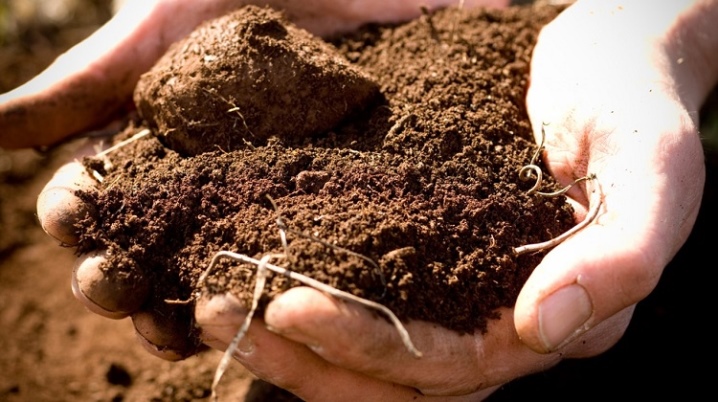
Landing in open ground
In general, two periods can be distinguished that are suitable for planting daffodil bulbs - these are spring and autumn.
If we talk about autumn planting, then it is better to place the bulbs in the ground at the end of August or at the beginning of September. It was at this time that the planting material takes root well in the soil and begins to actively develop the root system. If the planting was carried out later than the specified date, the roots will not have time to grow before the onset of cold weather, and the bulb may die from frost, especially if it was initially weakened. It also happens that the planting material appeared unexpectedly, and the optimal dates for the autumn planting have already passed. Do not despair: the bulbs can be placed on the garden at the end of October, but in this case, for additional protection from frost, the flowerbed will have to be covered with a thick layer of humus or fallen leaves.
Productive spring planting in open ground is possible only if the planting material has previously been cold treated (Figure 2). Such a cold period is necessary for the normal development of the bulb and subsequent abundant flowering.
If you plan on planting daffodils in your garden in the spring, it is advisable to keep them in the refrigerator, wrapped in paper or plastic wrap during those winter months. At the same time, the planting material must be periodically inspected in order to remove the diseased specimens and prevent infection of the rest.
Among the basic rules for spring planting are:
- Before planting, all planting material must be examined and all diseased or damaged specimens must be removed. It is strictly forbidden to plant them in the ground. At best, they will not germinate, and at worst, they can become a source of infection for all other plants in the flower bed.
- The procedure is carried out only after the soil has completely thawed. Planting bulbs in frozen ground is, firstly, problematic, and secondly, it will not bring the desired result, since planting material may simply die in frozen soil.
- The soil in the flowerbed must be dug up and all weeds are removed, and then the bulbs are placed in the ground to a depth of 15 cm. In this case, the distance between individual specimens should be about 15-20 cm so that the flowers have the opportunity to grow to the sides.
 Figure 2. Before spring planting, the bulbs must be cold treated
Figure 2. Before spring planting, the bulbs must be cold treated
Regardless of the planting season, it is not recommended to deeply deepen the bulbs, as this can provoke a delay or complete absence of flowering. It should also be borne in mind that plants planted in autumn will begin to bloom as early as next spring, and with spring planting, this period will come a little later.
Lack of flowering
Many gardeners complain that daffodils do not bloom, but at the same time strong and healthy leaves appear from the bulbs. There are several reasons for this behavior:
- Lack of lighting. The buds will form, provided that the sun's rays fall on the flower bed at least part of the day. Under trees with a dense spreading crown or closely spaced tall shrubs, daffodils will grow a green mass without peduncles.
- Insufficient watering. During the period of active growth in spring and during the growth of the bulb, which takes about 6 weeks after the buds wither, the plants need a lot of moisture.
- Excess nitrogen in the soil. Nitrogen stimulates foliage growth to the detriment of flowering.
- Thickening of the area with daffodils. Occurs when bulbs grow rapidly and compete for nutrients, oxygen, and moisture in the earth.
- Recent boarding or transferring. Plants may not bloom in the first or second year after planting in a new place - this is a clear sign of their adaptation to new growing conditions.
- Premature removal of leaves before they wilted naturally. Through the leaves, the bulb receives the substances necessary for the establishment and formation of the future flower, therefore they cannot be cut off ahead of time.
- Spring planting, absence of a cold dormant period and maintenance in winter at air temperatures above + 10 ° С.
- Sour soil in the area with daffodils. The pH can be lowered by liming (lime, ground chalk, dolomite flour).
Despite the impressive list, the real reason why daffodils refuse to release flower stalks is not difficult to determine - it is enough to analyze the planting and care process, and then correct them.
Daffodil planting dates
Traditionally, daffodils are planted in the fall, before frost. In warm autumn, useful substances accumulate, flower bulbs are strengthened, their root system is actively developing. The optimal planting time is late August - early September
It is important to remember that the strengthening of the bulb occurs within 20-25 days. Therefore, it makes sense to study the nearest weather forecast, and based on this information, plan the landing dates.
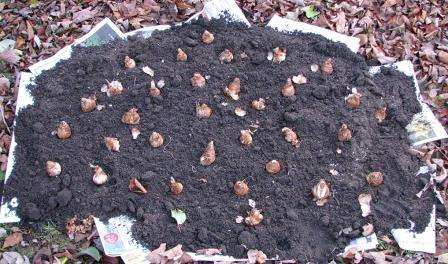
It is possible to plant flowers in late September - early October only in the southern regions of the country. However, even in these cases, it is necessary to insulate the soil with dry foliage, needles or humus.Some gardeners plant daffodils in the spring. In this case, you can wait for flowering only next year.
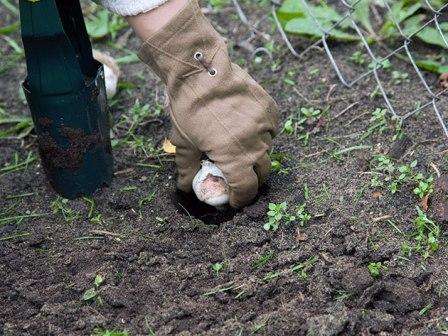 Planting daffodil bulbs
Planting daffodil bulbs
Choosing a landing site. Daffodils are quite unpretentious plants. They can be planted both in a well-lit area and in the shade of trees. The only exceptions are some varieties of daffodils. For example, Assoan and bouquet daffodils are best planted in sunny places. Only in this case bright and large flowers will appear in the spring. Some pink and orange varieties, on the other hand, require a shade space, as the flowers can completely fade in the sun. The shade should not be too dense. You can plant flowers near shrubs or on a small slope. In addition, you should choose a place in which there are no drafts.
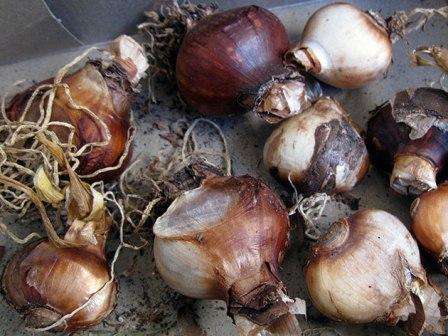
You cannot choose areas with a high content of groundwater if the soil does not allow moisture to pass through well. In such soil, daffodil bulbs can rot and die. Daffodils go well with almost all colors. Therefore, they can be safely planted in an already formed flower bed. These bulbous flowers work best with crocuses, tulips and lungwort.
Soil preparation. Loamy soil is ideal for daffodils. In sandy or infertile soil, plants will bloom well only in the first year. In this case, their growth and flowering occurs due to the nutrients that have been accumulated earlier. In the future, the flowers will begin to shrink, gradually their flowering will stop. River sand should be added to clay soil, and soil with a high sand content, on the contrary, should be diluted with humus.
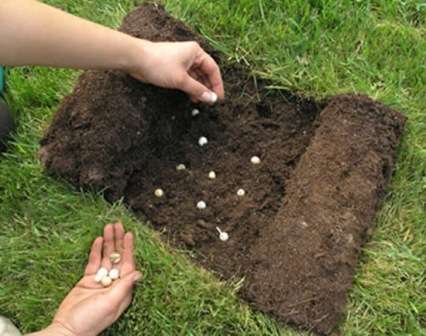
1 or 2 months before planting daffodils, a plot of land must be dug to a depth of at least 40 cm. Bulbous flowers require a well-drained and fertile soil. Therefore, before planting, you need to fertilize the soil with humus, compost or special mineral fertilizers containing potassium and phosphorus. Gardeners do not recommend fertilizing the soil with manure. This can be done only six months before the intended planting of flowers. Additionally, river sand can be added to the soil.
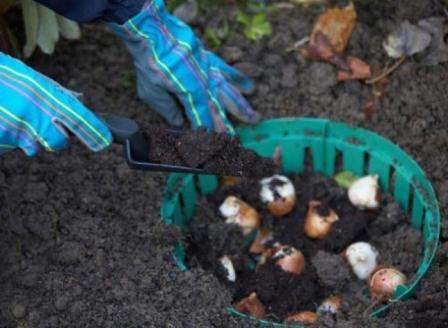
The choice of planting material. In order for the daffodils to bloom in the spring, it is necessary to choose the right planting material. Bulbs must not have:
- Rot.
- Mechanical damage.
- Black or dark brown loose areas.
In addition, the bulbs need to be cleaned of the top, dry scales. You can only remove the top layer. If you peel the bulbs to a layer of white scales, the plant will die. Large bulbs should be chosen for good flowering and small ones for flower propagation. It is better to purchase daffodil bulbs in advance, in the summer. So that the planting material does not deteriorate, it must be stored in a dry, cool room. The bulbs should be protected from sunlight.

Do not store daffodils in closed bags, as they can deteriorate and rot. For storage, choose open wooden boxes or baskets. Ideally, the bulbs should not be stacked on top of each other, they should be placed separately. Before planting, daffodils are recommended to be treated with fungicidal preparations. This will protect plants from fungal and bacterial diseases.
How to plant daffodils in the fall?
It is customary to plant daffodils in dense groups. However, the distance between the bulbs should not be less than 10 cm. By reducing this distance, you can increase the propagation rate of the bulbs. You need to plant flowers as follows:
1. Make holes in the prepared soil. Their depth should depend on the size of the bulb. Typically, the hole should be 3 times the size of the bulb. However, planting depth depends on the type of soil. In heavy loamy soil, smaller holes can be formed, in light sandy ones, on the contrary, large ones. Gardeners recommend planting daffodils at different depths. Thanks to this, the plants will bloom for longer.
2. Add a handful of river sand to the bottom of the holes. This will increase the drainage effect and protect the flowers from pests.
3.Place the onion in the hole, sprouts down.
4. Sprinkle the daffodils with soil with the addition of fertilizer. You can use ash, humus, special fertilizers.
5. Water the planted flowers well.
Caring for daffodils after planting
After planting, the grower must create favorable conditions for strengthening the daffodil bulbs. On the eve of frost, a flower bed with daffodils should be covered with a layer of dry leaves, peat or sawdust. If the winter in the area is expected to be cold and with little snow, you need to additionally insulate the flower bed with special materials: agrofibre or lutrasil. Daffodil stems appear in the spring. The gardener needs to carefully inspect the flower bed and remove damaged rotten bulbs.
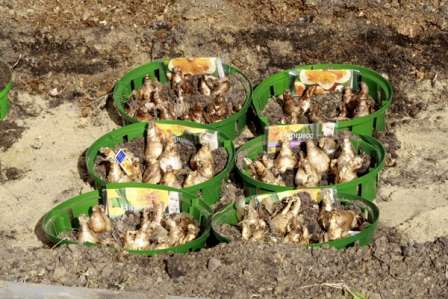
In early spring, it is necessary to fertilize the soil with ammonium nitrate. A little later, before flowering, fertilizers containing phosphorus and potassium should be applied. If you follow these rules, the flowers will be large and the bulbs will multiply much more intensively. During flowering, daffodils need to be watered in a timely manner and the soil should be loosened regularly.
Common mistakes when planting daffodils
- Violation of landing dates. If daffodils are planted too early, they will grow in cold weather. Flowers will not withstand low temperatures and will die. Late planting is dangerous because the root system will not have time to form by spring flowering.
- Dig up the bulbs earlier. Daffodils don't have to be dug out of the ground every year. However, if you need to get the bulbs, you must wait until all the leaves turn yellow, otherwise the plant will die.
- Violation of storage conditions. Daffodils must go through a cooling period. That is, before disembarking, they should be stored in a dark, cool place. If this condition is not met, the plant will be susceptible to various diseases.
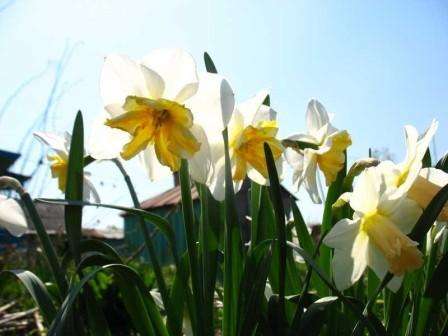
Daffodils need to be replanted every 5 years to a new location.
In addition, it is imperative to pay attention to the care recommendations for a particular variety. Despite the fact that daffodils are considered unpretentious plants, in order for them to please gardeners with their color for many years, all the rules of planting and care must be followed
Growing daffodils in the garden
How to grow daffodils
Daffodils appear early in the garden, one of the first, along with hyacinths, crocuses and tulips. The flower itself is not capricious, but it is better for sloths not to mess with it, because only a responsible florist can grow a daffodil the way it should be
It is very important to choose a suitable site for planting daffodils: it must be well-lit, permeable, the most favorable soil is neutral loam, fertilized with compost or humus, but not manure. If the soil is too alkaline, you can add 200 g of dolomite flour per square meter to it, and the increased acidity is reduced with wood ash at the rate of 1 glass per 1 m². Do not plant daffodils where tulips, lilies or other bulbs have recently grown, as well as perennial asters, phloxes, and chrysanthemums.
But after cereals, legumes, nightshades, peonies and cucumbers - please
Avoid planting daffodils where tulips, lilies, or other bulbs have recently grown, as well as perennial asters, phloxes, and chrysanthemums. But after cereals, legumes, nightshades, peonies and cucumbers - please.
Daffodil bulbs
When warm days come, daffodil bulbs are planted in the ground. In the spring, many stores sell stale goods for a song, and this is a good chance to buy the bulbs of rare varieties of daffodils cheaply. Just be careful: do not buy soft or weakened bulbs that may not sprout at all, but if the plant, despite your fears, still grew, try to pay more attention to it. The best time to buy daffodil bulbs is three months after flowering.
How and when to plant hyacinths so that they bloom in the same year
It is undesirable to buy bulbs:
- in the spring;
- those that were dug up with stems, flowers and roots during flowering or immediately after;
- multi-peaked, if it has only one large onion, and the rest are small;
- which have already shown a sprout.
In the photo: Blooming daffodil in a flower bed
Before planting, daffodil bulbs should be examined and discarded too soft, diseased or damaged, with an affected bottom. Healthy ones for disinfection are kept for half an hour in a three percent solution of a fungicide or a one percent solution of potassium permanganate.
Planting daffodils in spring
Dig planting holes in the prepared area, the depth of which should be equal to 3 onion diameters. Then a handful of sand is poured into the hole, 2 large tablespoons of wood ash are poured into the hole and an onion is placed there. Fill the hole up to half with soil mixed with compost and water well, then fill it to the top with soil and tamp its surface.
The distance between the planting holes depends on whether you will be planting daffodils after 1 year or whether they will grow in this area for 5 years. In the event that you decide to seat them, then the distance between the holes should be from 7 to 10 centimeters. If they grow in the same place for 5 years, in this case the distance between the bushes should be from 15 to 20 centimeters. When planting is complete, it is recommended to cover the surface of the soil with a layer of mulch, which can be used as nutshells, chopped straw, sawdust of hard trees or cut grass. A layer of mulch is able to restrain the growth of weeds, and it also prevents moisture from evaporating from the soil very quickly. Also, mulch is good in that the surface of the area covered with it does not need to be loosened after each watering.
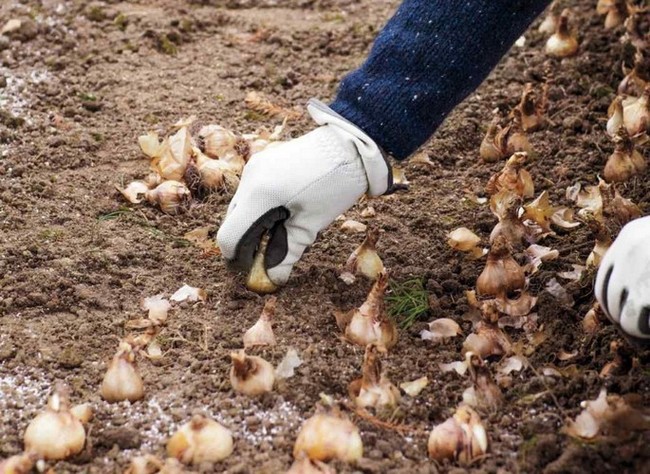
How to plant daffodils outdoors in autumn
Having decided on the site, digging it up with fertilization and preparing the bulbs, you can start the planting process (Figure 3).
It is done like this:
- First of all, you should dig the planting holes, the depth of which should correspond to the size of the planting material. So, for large bulbs, it should be from 20 to 25 cm, and for smaller ones - from 10 to 25 cm.
- At the same time, the following interval between the pits is adhered to: 15-20 cm if the planting material is large, and 7-10 cm for planting children.
- The next step is to fill the bottom of each hole with a layer of sand and lay out the bulbs. They must be placed with the bottom down, lightly pressing into the sand. If you plant them the other way around, they will still sprout, although much later. In addition, their peduncles will be strongly curved, and the flowers are much smaller in size, and the abundance of flowering will sharply decrease.
- When starting to fill the holes, do not forget to sprinkle each bulb with wood ash, then fill the holes with soil halfway down.
 Figure 3. The main stages of autumn planting
Figure 3. The main stages of autumn planting
Add complex mineral fertilizer to the remaining soil and cover the remaining space of the holes with the resulting substrate.
In what month
When determining the most optimal month for planting daffodils, pay attention to the weather and climatic features of the region in which you live. And although the recommendations of gardeners indicate that it is best to plant daffodils for the winter, starting in the second half of August and ending in mid-September, please note that these periods are average and do not take into account the conditions of a particular area.
Therefore, it is best to focus on the temperature indicators of the soil over a period of time. So, experts advise planting daffodil bulbs only when the soil temperature is set at around +8 to +10 degrees and will hold out unchanged for two weeks. In this case, the root system will have time to develop well for reliable rooting of the plant. Conversely, the roots of late-planted bulbs will be too short, which can lead to the death of the plant.If planting is still late for any reason, mulch your daffodil beds with humus or fallen leaves to help plantings keep warm during cold weather.
How to plant daffodils outdoors
The technology to be followed when planting daffodils in open ground is fairly simple and usually does not cause any difficulties even for beginners in this business.
A detailed description of this process is given below:

Initially, on the site of the future flower bed, the earth is carefully dug up and loosened, if necessary, you can add a small amount of coarse sand or suitable fertilizer mixtures to it.
Then the planting holes for the bulbs are prepared. Their depth is determined individually in each specific case, usually it is equal to three times the size of the tuber itself. In most cases, the indicator is 10-13 cm for adult bulbs and 8-10 cm for children, but the quality of the soil also matters: if planting is carried out in a sufficiently light soil, then the depth can be further increased by another 5 cm.
A distance of about 15-20 cm should always be maintained between adjacent holes, but when growing miniature varieties, it can be reduced to 10 cm
If planting is carried out in order to quickly obtain children, then the distance increases to 25-30 cm, which will allow the tubers to develop and grow faster.
A small amount of sand is poured onto the bottom of the hole so that a thin layer is formed, which will act as drainage, and also prevent direct contact of the planting material with the applied fertilizers.
Then the bulb itself is carefully placed inside: it is necessary to place it correctly so that the root processes are directed downward.
The planting site is slightly moistened if there has been no precipitation for a long time, and then it is covered with a mixture of sand and garden soil. At this, the planting procedure can be considered complete, in the future it is only necessary to take care of the daffodils.


